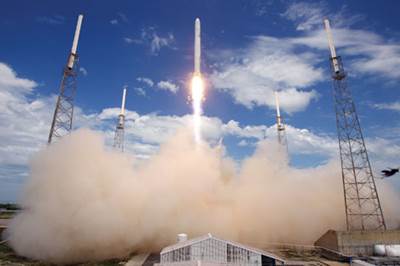U.S. crew and cargo candidate takes shape with composites
Crew-capable Dream Chaser to enable ISS transport missions from U.S.
Design Results:
- Carbon fiber/bismaleimide (BMI) composites form primary and secondary structures.
- Major component skins are cobonded and cocured with spars and/or ribs.
- Tailored 3-D preform architecture reinforces major component bond sites.
When NASA retired its Space Shuttle fleet in July 2011, its successors were the Constellation Program, aimed at exploration of the Moon and resumption of service to the International Space Station (ISS), and the Commercial Crew & Cargo Program (C3PO), established in 2006 to encourage development of commercial spacecraft by private industry. When the Obama Administration canceled Constellation in 2011, NASA shifted gears and instituted a new space exploration program aimed at sending humans deeper into space than ever before. The new effort includes development of NASA’s Multi-Purpose Crew Vehicle, Orion (see “The private space race,” under "Editor's Picks," at top right).
Privatizing low-Earth orbit transport
NASA has refocused on beyond-Earth orbit (BEO) goals and handed over the task of low-Earth orbit (LEO) transportation to the commercial sector. NASA provides technical expertise and financial investment in C3PO’s Commercial Orbital Transportation Services (COTS) program and Commercial Crew Program (CCP), but it “is an investor without equity,” explains Ed Mango, CCP manager at Kennedy Space Center. “The success of the program [is] its only return on investment,” he says.
C3PO manages the COTS partnership agreements with U.S. industry, and as of February 2013, it had invested $800 million in cargo demonstrators. COTS was the stimulus for Space Exploration Technologies’ (SpaceX, Hawthorne, Calif.) pilotless cargo module Dragon — the first commercial spacecraft to dock on the ISS and return home.
COTS is strictly for cargo transport, but under the CCP banner, NASA established a $440 million award for Commercial Crew Integrated Capability (CCiCap), which is designed to get humans back into LEO (180 to 2,000 km/112 to 1,243 miles) on a domestic spacecraft. According to Mango, “The next time a U.S. rocket and spacecraft are flying, it will be through CCP; there will be nothing else first with people on board.”
In 2009, NASA kicked off this program by investing $50 million in initial Commercial Crew Development (CCDev), basically a primer for CCP. This was followed by a $270 million award to four companies for further development, based on criteria for crew-carrying craft that stress safety and reliability.
In December 2012, based on work accomplished to that point in CCDev, NASA awarded about $10 million each to three of the competing companies for certification of flight safety and performance requirements for their spacecraft systems: SpaceX; The Boeing Co. (Houston, Texas); and Sierra Nevada Corp. Space Systems (Sparks, Nev.).
To the ISS and back
Sierra Nevada’s spacecraft, the Dream Chaser Space System (DCSS), is engineered to provide the U.S. with a piloted craft designed to make 25 round trips to the ISS with a crew of seven plus cargo. Derived from NASA’s HL-20 reusable lifting-body concept, which was extensively researched for manned orbital missions at NASA Langley Research Center (Hampton, Va.), the craft is capable of free flight in LEO, docking with the ISS and reaching “other orbital destinations,” says Frank Taylor, director of technology for Sierra Nevada’s Space Exploration Systems. “Its low-gravity reentry (<1.5 gs) and low-impact horizontal landings on a conventional runway protects both the crew and samples that are returning from orbital science experiments.”
Taylor identifies Sierra Nevada’s main engineering challenge as choosing the materials and process for a human-rated space structure that can withstand temperature variations ranging from -54°C/-65°F to 177°C/350°F during the time period of each mission, and through repeated missions, without sacrificing the required strength and other performance properties.
“We spent a good deal of time in the early days of planning our vehicle and its long-term design path exploring and examining the trades between composites and other viable materials,” recalls Mark Sirangelo, executive VP and chairman of Sierra Nevada Corp. Space Systems. “In the end, we came to believe that the use of composites was not only superior for this application in a technical sense but also significantly aided our ability to meet our expected market demand.”
Sierra Nevada Corp. elected to use composite materials in both primary and secondary structures, including the cabin, bulkhead, canted fins, aerosurfaces and aeroshells. It is primarily carbon fiber preimpregnated with bismaleimide (BMI) resin, in both woven fabric and unidirectional tape, in a sandwich structure with an unidentified nonmetallic honeycomb core.
The materials selection was narrowed to products supplied by Cytec Engineered Materials (Tempe, Ariz.) and Hexcel Corp. (Stamford, Conn.). “Cytec’s 5250-4 and Hexcel’s M65 BMI prepregs are being used in discrete areas of the structure, based on the unique characteristics of each,” Taylor reveals. “These materials retain good strength at high temperature.” Further, he says, their low coefficients of thermal expansion (CTE) minimize the effect of thermal gradients within the structure. The high specific stiffness (modulus) of the composite minimizes strains on heat shield. Similar to the ceramic tiles and blanket materials used on the Space Shuttles, the heat shield minimizes the thermal strains imposed on the vehicle by extreme thermal gradients during reentry into Earth’s atmosphere. Taylor says this results in a more efficient system and better protects the crew and cargo.
BMIs come of (space) age
BMI resins, now a leading class of thermosetting polyimides, reportedly offer the highest service-temperatures of any thermoset — some can withstand up to 230°C to 290°C (450°F to 550°F) in extended service. Further, they offer familiar, epoxy-like autoclave processing.
In LEO, structural materials also must be shielded from atomic oxygen, single oxygen atoms (O) that, like peroxide, are extremely reactive oxidizers. Exposed epoxy-based composites are subject to substantial oxidation and erosion. BMIs also tend to oxidize in atomic oxygen, so the Dream Chaser will be shielded by an unidentified protective coating.
Although details about the fiber architecture are proprietary, Taylor says Sierra Nevada fully exploited the ability to tailor fiber architecture and layup and, thus, the mechanical strength and stiffness properties, “to meet the challenging launch/abort, reentry and landing environments that the Dream Chaser vehicle is exposed to during its mission.” Stiffness is a vital factor because aerodynamic and launch forces subject all materials to significant vibration, acoustic and bending loads. Impact resistance is another requirement for protection against damage from the occasional micrometeoroid.
Taylor also cites the time and cost savings that have accrued to the program through the use of composites, due to their flexibility in manufacturing. Tooling and manufacturing costs have been reduced through parts consolidation. For example, the crew cabin comprises only two shells, or skins, cobonded with multiple internal frames. The fins, too, are cobonded parts that combine upper and lower skins with three spars and multiple ribs. Further, as the vehicle’s structural design matures, tooling changes for composites can be made more rapidly than is possible in metals fabrication. “The ability to produce additional vehicles more rapidly and to produce modified versions of the Dream Chaser to meet future client needs gave us greater confidence in our business plan,” says Sirangelo.
All composite parts will be autoclaved at the recommended time and temperature for the material (~350°F to 400°F/~177°C to 204°C). In structural assembly operations, Sierra Nevada will minimize the need for fasteners by employing a combination of cocuring and cobonding in an autoclave, incorporating the honeycomb core and advanced 3-D woven preforms. The 3-D preforms will be cobonded at most joints to further strengthen the structure.
Sierra Nevada is working with partner organizations in more than 15 states to develop the Dream Chaser. Lockheed Martin Space Systems Co. (Littleton, Colo.), an exclusive partner on the certification products contract (CPC), will build the tooling and composite structure for the Dream Chaser at its facility in Ft. Worth, Texas, and at NASA’s Michoud Assembly Facility in New Orleans, La. — the facility that built the external tanks for the Space Shuttles. Lockheed Martin brings to the partnership extensive experience in building composite structures for spacecraft and high-performance aircraft. Given Lockheed’s concurrent work on NASA’s Orion vehicle, the company also brings to the Dream Chaser program its long experience in obtaining NASA certification for a crewed flight vehicle.
Looking to launch certification
The Dream Chaser’s onboard propulsion system is the same hybrid rocket motor technology developed by Sierra Nevada for the carbon composites-intensive SpaceShipOne and SpaceShipTwo suborbital vehicles, built by Scaled Composites (Mojave, Calif.) for space-tourism company Virgin Galactic (Las Cruces, N.M.).
The Dream Chaser is designed to launch vertically on a United Launch Alliance (ULA, Centennial, Colo.) Atlas V rocket, which has had 100 percent mission success in more than 36 launches from Cape Canaveral, Fla., and Vandenberg Air Force Base, Calif. Sierra Nevada and ULA have integrated the Dream Chaser and Atlas V designs since the program’s inception and are now working with ULA’s Human Launch Services to achieve human rating for the spacecraft. “Our longstanding relationship has allowed us to greatly evolve our integrated crew transportation system and gives the DCSS the advantages, such as flight-proven reliability, that only a mature launch system can provide,” says Sirangelo.
Related Content
Composites manufacturing for general aviation aircraft
General aviation, certified and experimental, has increasingly embraced composites over the decades, a path further driven by leveraged innovation in materials and processes and the evolving AAM market.
Read MoreInfinite Composites: Type V tanks for space, hydrogen, automotive and more
After a decade of proving its linerless, weight-saving composite tanks with NASA and more than 30 aerospace companies, this CryoSphere pioneer is scaling for growth in commercial space and sustainable transportation on Earth.
Read MoreThe potential for thermoplastic composite nacelles
Collins Aerospace draws on global team, decades of experience to demonstrate large, curved AFP and welded structures for the next generation of aircraft.
Read MoreCryo-compressed hydrogen, the best solution for storage and refueling stations?
Cryomotive’s CRYOGAS solution claims the highest storage density, lowest refueling cost and widest operating range without H2 losses while using one-fifth the carbon fiber required in compressed gas tanks.
Read MoreRead Next
The Private Space Race
NASA passes the development torch to legacy contractors and NewSpace entrepreneurs, igniting a new competition in space transport.
Read More“Structured air” TPS safeguards composite structures
Powered by an 85% air/15% pure polyimide aerogel, Blueshift’s novel material system protects structures during transient thermal events from -200°C to beyond 2400°C for rockets, battery boxes and more.
Read MoreDeveloping bonded composite repair for ships, offshore units
Bureau Veritas and industry partners issue guidelines and pave the way for certification via StrengthBond Offshore project.
Read More






















.jpg;maxWidth=300;quality=90)







